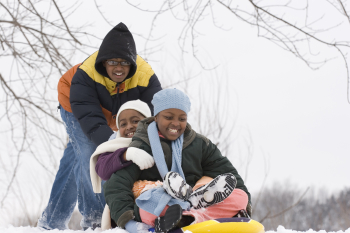
As any parent of a toddler probably knows children aren’t always fond of coats, and getting ready to leave the house on a cold day can be so daunting it’s easier just not to leave the house at all. Beyond feeling constricted by an additional layer of clothing, another problem children have with jackets is that they often are not feeling as cold as the adults in their lives. This can be attributed mostly to the fact that children are often running around like crazy, they’re often active enough that they don’t feel the coat is necessary.
But with bitterly cold temperatures blowing into our area once again it is important to brush up on our winter weather safety and recognize the signs and symptoms of cold-related emergencies. The general rule when dressing young children for outdoor winter play is to put them in one more layer than an adult would wear in the same weather. According to Parents Children shouldn’t be sent out to play if the windchill is lower than 10° F. For babies be sure that fingers, toes, ears, nose, and chin are covered buty they can still breathe easily.
Car Safety:
Puffy jackets, blankets or snowsuits should never be worn while in a car seat, leaving bulky winter items on while the child is in a car seat could cause the straps to be too loose and not properly restrain the child in the event of a crash. Performing a Puffy Coat Check on your child’s jacket can help you see if it is too bulky to be worn while in a car seat. After your child is in their seat you can use blankets to keep them warm, aftermarket car seat covers approved by the car seat manufacturer , or for older children put their coat on backward so that it acts like a blanket over the harness.
Know the Signs:
Prevention is key to avoiding cold-related emergencies like hypothermia or frostbite, but should something happen make sure to know the signs. According to the Red Cross signs of frostbite include lack of feeling in the affected area; skin that appears waxy, is cold to the touch, or discolored (flushed, white or gray, yellow or blue). If someone is suffering from frostbite don’t rub the affected area. Instead move them to a warm place, warm gently by soaking the affected area in warm water until it appears red and feels warm, and loosely bandage the area with dry, sterile dressings.
Extremely cold temperatures can cause frostbite in a matter of minutes, but those temperatures can also cause hypothermia. Signs of hypothermia include shivering, numbness, glassy stare, apathy, weakness, impaired judgment, and loss of consciousness. If someone is suffering from hypothermia call 9-1-1, and move the person to a warm place. Warm the person slowly by wrapping in blankets or putting them in dry clothes while you wait for paramedics to arrive.
